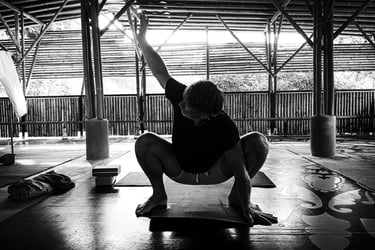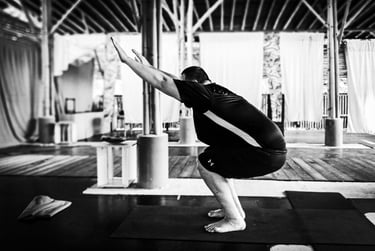The Squat : Strength and Stability
Squatting promotes muscle strength and coordination in the legs, hips, and core, which are crucial for stability, balance, and overall physical development at all ages. It can also help reduce the load on the lower back, potentially aiding in the management of back pain. Additionally, squatting is often credited with aiding digestion and easing bowel movements, and it may assist pregnant women during labor by helping to open the pelvis.
The squat and the chair pose (Utkatasana) share several anatomical similarities. Both involve deep flexion at the hips, knees, and ankles. In both poses, the hips hinge backward as the knees bend, lowering the body while keeping the chest lifted.
The quadriceps (muscles at the front of the thighs) are similarly activated to support the body during the descent. The gluteal muscles (buttocks) are engaged in both poses to stabilize the hips and assist with movement. Additionally, the hamstrings help control the downward motion and stabilize the knees.


Our bodies are naturally capable of deep squatting, a position where the hips rest close to the heels. This position is often seen in toddlers and young children, who instinctively squat while playing. The ability to squat deeply is a fundamental movement that emerges early in life, often as we learn to stand and move without support.


Both poses emphasize maintaining a straight or neutral spine, requiring the engagement of the spinal muscles to support the back and maintain posture. This also demands activation of the core muscles to stabilize the torso.
Despite these similarities, the depth and specific focus of the movements vary between different squat variations and the chair pose. However, both poses involve the coordinated effort of numerous muscles, large and small, working together in a similar way.
This makes the chair pose an effective practice for reacquainting practitioners with the muscle control needed to transition into a full squat gradually
More Insights
